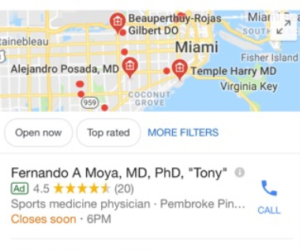Start here to rise to the top of internet listings for doctors, surgeons, and medical practices.
Remember the printed yellow pages? Remember “AAero Ventilation” and “AA-Able Accounting”? These businesses learned that customers typically choose from the first names they see. So they adapted, using the alphabetized system to get more customers.
Now, people use the internet as their local directory, especially to choose doctors and surgeons. Yet the principle is the same: Understand the listing system, then adapt to be at the top of the list and attract clients. Use these basics to improve your success:
- Adapt by understanding “the pack,” which is the small list of top local search results.
Internet search engines can usually tell when a person is searching for a local person or service. They deliver a small list of what they think are the best results in “the local search pack,” called “the pack” for short.
You really want to show up in the pack. It is usually only 3 names long, and people have to click again to see a longer list. More powerful than the yellow pages, the pack shows people not only names, but also enough detailed information to make a decision, plus buttons that encourage immediate action:
 A large map showing dots for all nearby results. For the top 3 listings—those in the pack—the map shows large location pins with large-text names.
A large map showing dots for all nearby results. For the top 3 listings—those in the pack—the map shows large location pins with large-text names.- List of the top 3 names*, highlighting services that match the search terms and showing the average star rating from online reviews.
- Action triggers and buttons: a “website” button to immediately deepen their interest in you; your business hours and current open status; your city and miles away plus a “directions” button for a quick decision to come to you; and a phone number or “call” button to press and call immediately.
A potential customer may never look further than the pack. Read on to learn more about how you can be in it.
*When an advertised name is also displayed, it is always clearly marked as an ad, and has a different color of map pin.
- Adapt by creating a real internet listing page, for each doctor in your practice.
Internet search engines reward businesses and providers that have created a search-engine-friendly listing page.
For best results, create a listing page not just for your overall practice, but also for each doctor by name. You create these listings using Google, Bing, or Yahoo.
A listing page is different from your website. No matter how well-designed your website is, you depend on internet search engines to find you and put your name in front of people. If your competitors are using a listing page and you are not, they will probably rank higher than you. With so much information provided in the pack, potential customers may not even visit websites–and especially not the websites of providers they cannot see in the pack.
- Adapt by keeping your address current, with a dedicated internet page for each address where a provider meets with patients.
Search engines choose doctors and practices closest to the person doing the search.
Always list the addresses where doctors actually meet with patients. If doctors meet with patients at more than one office, create an extra listing page for each address.
Not understanding, sometimes medical practices enter a listing address for their billing or management office. Or, they might just list one of the addresses where a doctor keeps office hours. But these addresses might be far away from the patient, meaning the doctor could be right next door but not turn up in local search.
- Adapt by entering specific services on your listing page and website.
Search engines look for the closest match to entered search terms.
Use the listing page to create a “menu” of different services, procedures, and specialties. In addition to more general categories, listing these specifics may better match a customer’s search and help your ranking.
It can be tempting to list only a general title or category in the listing page. For example, because many orthopedic surgeons do many types of surgeries, it might seem more descriptive to choose a general title. Or, it might seem more professional or prestigious. However, the internet listing page is not a LinkedIn account nor a CV. Instead, it is how a software algorithm will find you, through specifics.
- Adapt by getting frequent, positive online reviews.
Search engines prefer quality and authority. For local search, you show your quality and authority through a large number of high, current, online reviews.
Traditionally in the medical community, we think of authority earned through training, experience, research, and professional commitment. But search engines aim to please the searchers, so authority comes through customer perception in online reviews, rated 1-5 stars, through rating services like Google, Facebook, Yelp, Healthgrades, and Vitals.com.
Online reviews factor so highly in your online ranking that if you do not have high reviews, or if you do not have very many reviews, then you might not even make it into the local search pack. In fact, you might show up toward the bottom of the list below the pack no matter how good your service actually is.
Research suggests that most patients feel positively about the medical services they receive. Our results at Social Climb suggest that about 10% of customers will submit a review if prompted, and the majority of these are likely to be positive. Finding a way to regularly solicit online reviews is well worth your time.
Overall, you have to adapt, not only to grow but also just to stay in business.
Excellent skills and customer care are the real goal we all hope to offer. Yet these are not enough in today’s business climate. To help patients, first, you have to be seen, and then you have to look trustworthy. And you must do this through the internet. You must understand how the internet chooses you so that your potential customers can choose you too.
Learn how Social Climb’s powerful tools can make local search work for you.











